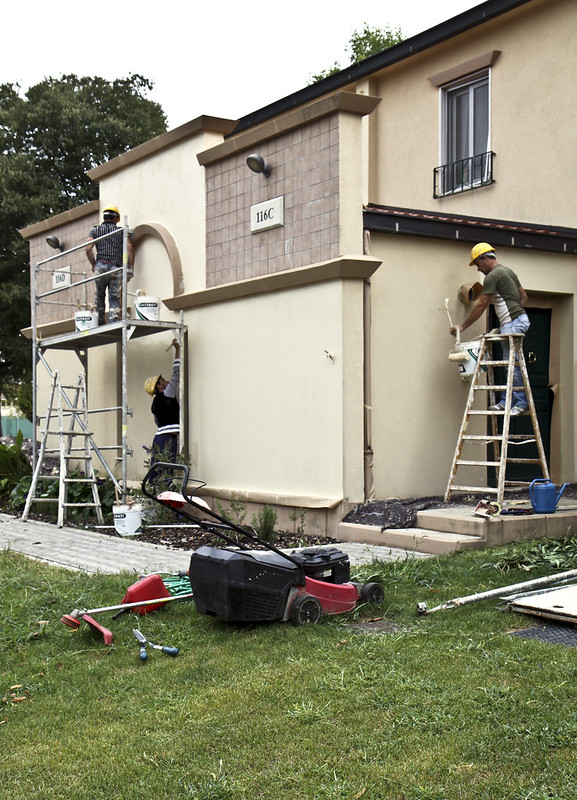The exterior paint and finish of your home is the first thing noticed by many people. House exteriors lend identity and personality to your home and act as a prelude to the house interior.
Therefore, it is essential to maintain your house exterior and not leave it faded, chipped, and unfinished.

Hiring the right people to carry out your exterior painting is the next important thing. You can consult experienced, certified and accomplished contractors for your exterior painting project by searching for the nearest one that matches your requirements and standard.
Here are steps to painting the exterior of the house seamlessly and efficiently.
Washing the exterior is essential to remove any dust and debris on the house walls. The exterior walls may also house insect colonies like honeycombs and hornets nests, bird droppings, and other dirt splashed over.
Washing cleans your house walls and makes them ready for a fresh new paint coat.
The power washer is standard for washing the exterior. A power washer efficiently removes the loose and tough dirt from your house walls.
In the painting industry, the power washing process is considered similar to creating a fresh canvas for new artwork.
Pressure washers use 2500-3000 psi making it an effective way to deep clean surfaces.
Read Also:
Houses’ exteriors have outdoor equipment fitted, like roofing, pipes, and other attachments to walls.
The components are fastened to exterior walls using nails, adhesives, and other processes. Therefore, the paint services you employ must conduct a proper examination of the exterior walls.
The exterior wall examination is meant to identify anything that will prevent a smooth and durable paint surface.
Wooden surfaces especially need to be free of any rot. The wood should be solid with no uneven sounds if it is rot-free and healthy.
If there are any signs of wood rot or damage, repairs need to be made before proceeding with the paintwork.
The exterior walls of your house are built to endure different weather conditions. Eventually, over a period, it will fade, crack, and chip.
Thus, house conditions are subjective to the local weather conditions. In some regions, the temperature gets too high. Some are rather rainy and chilly with strong winds and showers.
The deterioration will happen in all types of weather but in different ways. Therefore, it is crucial to select painting contractors that are local and aware of the climatic conditions of the regions.
Local knowledge and experience are fundamental for comprehensive external wall repair work.
Simple examinations like tapping on the wall surface also reveal the possible fault zones that need scrapping.
Zones with hollow sound tend to have weak paint and need repair. Your painting contractor needs to have the experience to understand the situation and work on them.
If your paint contractor skips hollow paint zones scrapping, the new paint coats will come off quickly.
The quality and skills of the painter are no guarantee for a durable and pleasant exterior if your contractor skips the activity.
Caulking is another necessary activity to prepare your exterior walls for good painting. Caulk fills the gaps in the walls similar to sealants.
Caulk is to seal wall gaps where walls join. The joints are prone to compression and expansion depending on the exterior temperature.
Therefore, caulking the wall gaps maintains internal house temperature. Wall joints with no more than 1/8″ gap require regular caulking.
If the wall gaps are broader than 1/8″, a different procedure is used to seal the wall gaps.
Priming is necessary for exterior walls and crucial for spots that are scrapped and worked earlier.
However, if your house exterior paintwork has faded completely, priming the whole house is essential.
The house exterior wall spots comprising exterior walls and woodworks with scrapping and repair work require priming.
Masking is covering the areas of your exterior walls that do not require painting. The regions comprise exposed brickwork for aesthetics appeal, roof edges, windows, external fixtures, like lights and shingles.
3M™ Drop films are the preferred choice of many paintwork contractors. However, brown masking sheaths, Visqueen, and plastic sheathing also work fine.
Selecting a color for your house exterior is crucial. Occasionally, the paint selection process is more manageable, thanks to the options of colors limited by housing associations.
Many house owners prefer to paint the house with the previous color. The color selection also depends on the roofs, windows, and other external work like exposed brickwork.
Another important factor while selecting the color is the climatic conditions. The market has expansive exterior wall paints options with different properties providing better protection against diverse weather conditions.
Therefore, you or your paint contractor must have the necessary awareness regarding the weather to select the right paint for your house exteriors.